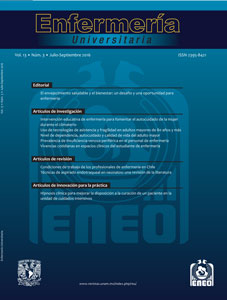Endotracheal aspiration techniques in neonates: a literature review
Main Article Content
Abstract
Introduction: In neonates under assisted ventilation, the endotracheal aspiration techniques become necessary in order to maintain the baby’s airway free of secretions. Within the hospital area, the practice of these procedures includes a closed and an open technique. Both are crucial for the correct management of these patients and should always be properly performed.
Objective: To analyze, through available scientific evidence, the advantages and disadvantages of the open and closed endotracheal aspiration techniques in the neonatal patient under assisted ventilation.
Methodology: A bibliographical review was conducted on the PubMed, CUIDEN, Cochrane, and LILACS databases. In addition, the reference lists of the selected articles were also examined. Development: After the review and application of the inclusion criteria, a total of six articles were selected for in-depth analysis.
Results and conclusions: The literature on the neonate under assisted ventilation suggests that the closed endotracheal aspiration technique offers more advantages because it maintains the pulmonary volume and the intracranial pressure within stable ranges, and also, it prevents hypoxia and hypoxemia, adequately maintaining the oxygen saturation, the capillary refill, and the cardiac frequency during the procedure.
Publication Facts
Reviewer profiles N/A
Author statements
- Academic society
- N/A
- Publisher
- Universidad Nacional Autónoma de México
Article Details
Dimensions citation
MÉTRICAS
Enfermería Universitaria by Universidad Nacional Autónoma de México it is distributed under the License Creative Commons Attribution - NonCommercial - NoDerivatives 4.0 International
Accepted and published articles become open-access under the terms of the Creative Commons CC BY-NC-ND 4.0 license, which authorizes the reproduction and sharing without commercial purposes, provided the corresponding acknowledgments to their authors. Authors are allowed to manage a self-archive copy of the article’s published version so that they can open-access it in their personal or institutional web pages, and/or any other broad-diffusion space.



